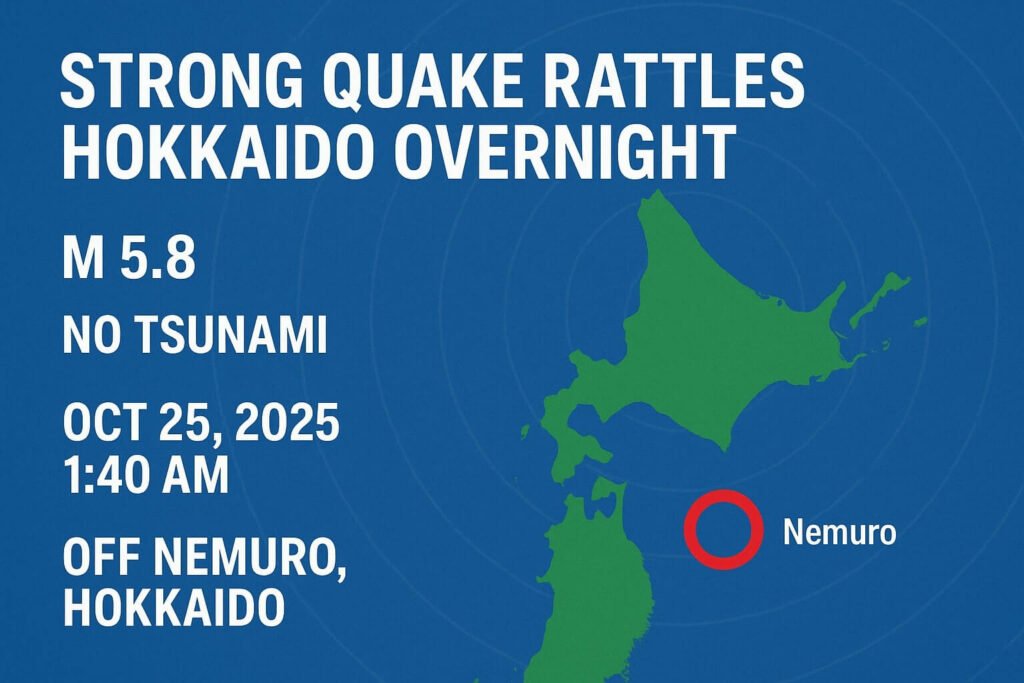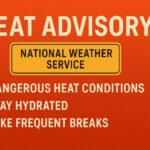In the quiet hours of Saturday morning, while much of eastern Hokkaido slept, the earth reminded everyone why Japan is one of the most seismically active countries on the planet. A strong offshore earthquake struck just southeast of the Nemuro Peninsula at 1,40 a.m. local time. Although there was no tsunami threat, the intensity was enough to shake buildings, wake residents, and trigger automatic shutdowns of some services. The keyword “earthquake now” started trending in real-time as local and international agencies rushed to assess the situation.
The Japan Meteorological Agency (JMA) reported the magnitude at around 5.9, though other sources like GFZ in Germany initially estimated it at 5.7. These small differences are normal. As data gets refined with more seismic readings, the numbers tend to settle. What matters most is not just how big the quake was, but how it was felt on the ground. That’s where the shindo scale comes into play, and this one registered a Lower 5 on that intensity scale, which is a solid shake by any measure.
A quake you can feel, but no tsunami this time
Eastern Hokkaido sits along the Kuril Trench, one of the most geologically active subduction zones on Earth. The Pacific Plate slowly pushes under the Okhotsk microplate here. That grinding motion creates pressure that builds over time, only to be released suddenly in events like the one we saw this weekend. This region sees its fair share of seismic activity, from mild tremors to significant events like this one. While the magnitude might not grab global headlines, the local impact is very real.
This quake was deep enough, around 40 kilometers below the surface, to reduce the risk of a major tsunami. That’s a relief. Shallow earthquakes under the seafloor are typically the most dangerous when it comes to generating waves. In this case, authorities confirmed early that there was no tsunami threat. Still, the shake was strong enough to trigger automatic safety protocols across the region. Elevators stopped. Gas valves shut. Trains halted for inspections. It’s all part of Japan’s sophisticated system to minimize risk.
The term “earthquake now” echoed across news feeds and social media as people tried to make sense of what just hit. Many were startled awake, grabbing their phones to check alerts. Some reported small items falling from shelves. Others noticed their furniture shift slightly. These are all consistent with a Lower 5 on the shindo scale. It’s a level where you don’t just hear about it later, you feel it yourself. You react. That human experience is what makes the term “earthquake now” so much more than a trending topic. It’s a moment shared across thousands of lives.
What happens after an earthquake like this
Aftershocks are to be expected. That’s normal. Already, smaller tremors have been recorded off the coast near Nemuro. These are usually mild but can feel sharp if they happen close to populated areas. For people living in eastern Hokkaido, it’s wise to secure heavy objects, double-check gas connections, and make sure emergency supplies are topped up. Flashlights, water, backup power, and even just knowing how to manually open a stuck window can make a difference.
Even when there’s no tsunami, the risk doesn’t fully end with the first quake. Aftershocks can startle. They can cause more items to fall if homes or buildings were already shaken loose. That’s why earthquake preparedness is a lifestyle in regions like this. It’s not just about reacting to the earthquake now. It’s about being ready for the next one.
Transportation networks may experience some ripple effects. Japan Rail often pauses services for safety checks when an area experiences intensity 4 or above. That’s not overkill. It’s smart. Infrastructure is only as safe as its weakest point after a quake, and verifying the integrity of rails, bridges, and tunnels protects lives. Airlines flying into nearby airports like Kushiro may also delay or adjust schedules briefly as a precaution. Travelers should check for updates, but no widespread disruptions were reported from this single event.
Living with the earth’s movements
One of the challenges with earthquakes is the uncertainty. We know where they tend to happen. We know how the plates move. But we cannot yet predict exactly when a fault will slip. That’s why “earthquake now” always feels immediate, even to those used to living in active zones. It comes without warning. And in places like Hokkaido, people take that uncertainty seriously.
This quake is a strong reminder of how vital it is to stay ready. Not in a state of panic, but in a state of quiet readiness. Keep your phone charged. Make sure you know where the flashlight is. Look around your space and ask what might fall if the ground shook again. That’s not fear. That’s smart living in a tectonic neighborhood.
If you felt the quake, your experience is valid even if there was no visible damage. Feeling the earth move beneath your feet changes your relationship with the land. For some, it’s a moment of vulnerability. For others, it’s just another page in the geological story of the region. Either way, it’s worth noting.
What to watch next
For now, aftershocks will likely continue for several days. Most will be too small to notice, but one or two might get your attention again. Authorities will monitor the region closely. The lack of a tsunami is good news. Infrastructure checks are routine. But stay alert. In the days that follow, don’t let your guard fully down.
Keep following updates from trusted sources like the Japan Meteorological Agency and your local municipality. Avoid rumors. Stick with what’s confirmed. Social media can be helpful for rapid impressions, but clarity comes from official data.
Lastly, if you’ve never done a household earthquake prep check, now’s a good time. Move that heavy vase. Check that bookshelf. Refill your water jugs. Being ready isn’t about predicting the next quake. It’s about being able to move smoothly when it arrives.


